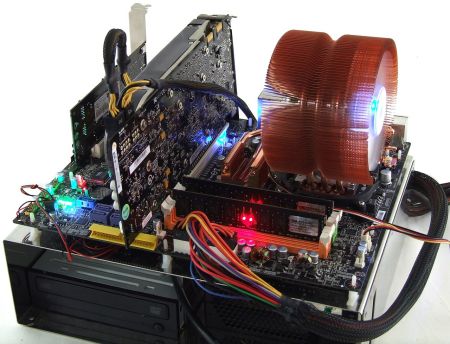Overclocking: Dual- vs. Quad-Core CPUs
Conclusions: Intel Quad-Core And MSI P35 Neo2 Get Our Nod
In general, we can say that overclocking definitely pays off, regardless of whether you choose the dual-core or the quad-core CPU. Either one of these processors is capable of a 25% speed increase, which is noticeable even with everyday computing tasks. The increased energy costs that result from overclocking is not especially pronounced with Core 2 processors; their share in the system's overall power consumption is so small that overclocking always pays off. The question whether you should opt for a dual-core or quad-core processor is easily answered as well.
In video-editing and 3D-rendering scenarios, the Core 2 Quad Q6600 is noticeably faster than the dual-core CPU Compare Prices on Core 2 Quad Q6600. On the other hand, it still trails its sibling when it comes to gaming. In our benchmark suite, only one of the six games supported the additional cores, allowing the Q6600 to catch up with the E6750. Bear in mind though that upcoming gaming titles, especially those expected this holiday season, will change this situation, bringing much better quad/multi-core support to the table. Only after this happens will the quad-core processor get our recommendation, even for the gaming enthusiast.
The quad-core can offer the user advantages even if applications offer "only" dual-core support, namely when background processes take up additional CPU time. Take anti-virus software scanning in the background, for example, or an archiving program that is extracting a file, which saps processor power from your main application. Tasks running in the background interfere much less with the main application when there are more cores at the system's disposal.
Seen from this perspective, the only argument remaining in favor of the dual-core Core 2 Duo E6750 is its lower price.
Compare Prices on Core 2 Duo E6750
Even though the dual-core model is able to reach higher clock speeds, the quad-core wins in the final analysis thanks to multi-threaded software. If you have the extra $88 to spare for the Q6600, we recommend you choose it over its little brother. In our opinion, the dual-core version simply isn't worth it any more. The situation is even more dire for the E6850, which costs as much as the Q6600, making it an even tougher sell.
That brings us to our other recommendation: the motherboard. Gigabyte and MSI provided us with review samples, and both boards proved to be excellent overclockers and were able to help the processor reach high FSB speeds. Of the two, we recommend MSI's P35 Neo2-FR or P35 Neo2-FIR. Despite their low price, these boards come with a heatpipe solution, which is the better choice for an overclocking board. As an added benefit, the MSI boards allow you to create a Crossfire configuration and offer an indispensable CMOS-reset function, which resets the BIOS at the touch of a button without clearing your settings.
Our recommended combination: The MSI board with GEIL memory.
To complete our overclocking system, we also recommend the CNPS9700 LED cooler by Zalman and GEIL's Black Dragon GB22 GB6400V4DC memory modules.
Current page: Conclusions: Intel Quad-Core And MSI P35 Neo2 Get Our Nod
Prev Page Video Encoding - CloneDVDGet Tom's Hardware's best news and in-depth reviews, straight to your inbox.
Tom's Hardware is the leading destination for hardcore computer enthusiasts. We cover everything from processors to 3D printers, single-board computers, SSDs and high-end gaming rigs, empowering readers to make the most of the tech they love, keep up on the latest developments and buy the right gear. Our staff has more than 100 years of combined experience covering news, solving tech problems and reviewing components and systems.

